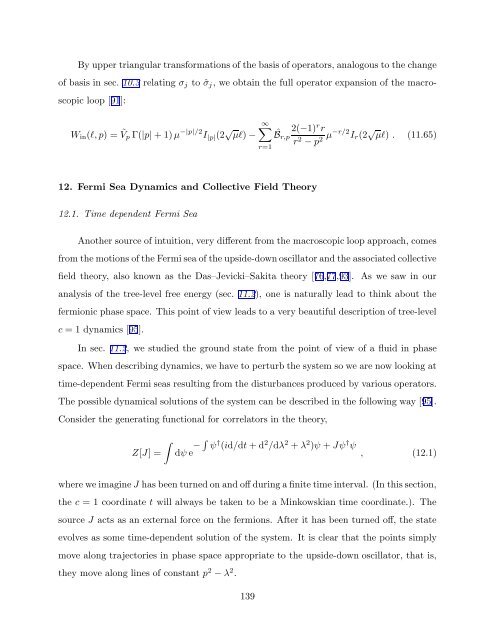arXiv:hep-th/9304011 v1 Apr 5 1993
arXiv:hep-th/9304011 v1 Apr 5 1993
arXiv:hep-th/9304011 v1 Apr 5 1993
You also want an ePaper? Increase the reach of your titles
YUMPU automatically turns print PDFs into web optimized ePapers that Google loves.
By upper triangular transformations of <strong>th</strong>e basis of operators, analogous to <strong>th</strong>e change<br />
of basis in sec. 10.3 relating σ j to ˆσ j , we obtain <strong>th</strong>e full operator expansion of <strong>th</strong>e macroscopic<br />
loop [91]:<br />
W in (l, p) = Ṽp Γ(|p| + 1) µ −|p|/2 I |p| (2 √ µl) −<br />
∞∑<br />
r=1<br />
ˆB r,p<br />
2(−1) r r<br />
r 2 − p 2 µ−r/2 I r (2 √ µl) . (11.65)<br />
12. Fermi Sea Dynamics and Collective Field Theory<br />
12.1. Time dependent Fermi Sea<br />
Ano<strong>th</strong>er source of intuition, very different from <strong>th</strong>e macroscopic loop approach, comes<br />
from <strong>th</strong>e motions of <strong>th</strong>e Fermi sea of <strong>th</strong>e upside-down oscillator and <strong>th</strong>e associated collective<br />
field <strong>th</strong>eory, also known as <strong>th</strong>e Das–Jevicki–Sakita <strong>th</strong>eory [76,77,93]. As we saw in our<br />
analysis of <strong>th</strong>e tree-level free energy (sec. 11.2), one is naturally lead to <strong>th</strong>ink about <strong>th</strong>e<br />
fermionic phase space. This point of view leads to a very beautiful description of tree-level<br />
c = 1 dynamics [95].<br />
In sec. 11.2, we studied <strong>th</strong>e ground state from <strong>th</strong>e point of view of a fluid in phase<br />
space. When describing dynamics, we have to perturb <strong>th</strong>e system so we are now looking at<br />
time-dependent Fermi seas resulting from <strong>th</strong>e disturbances produced by various operators.<br />
The possible dynamical solutions of <strong>th</strong>e system can be described in <strong>th</strong>e following way [95].<br />
Consider <strong>th</strong>e generating functional for correlators in <strong>th</strong>e <strong>th</strong>eory,<br />
∫<br />
Z[J] =<br />
dψ e − ∫ ψ † (id/dt + d 2 /dλ 2 + λ 2 )ψ + Jψ † ψ , (12.1)<br />
where we imagine J has been turned on and off during a finite time interval. (In <strong>th</strong>is section,<br />
<strong>th</strong>e c = 1 coordinate t will always be taken to be a Minkowskian time coordinate.). The<br />
source J acts as an external force on <strong>th</strong>e fermions. After it has been turned off, <strong>th</strong>e state<br />
evolves as some time-dependent solution of <strong>th</strong>e system. It is clear <strong>th</strong>at <strong>th</strong>e points simply<br />
move along trajectories in phase space appropriate to <strong>th</strong>e upside-down oscillator, <strong>th</strong>at is,<br />
<strong>th</strong>ey move along lines of constant p 2 − λ 2 .<br />
139
















